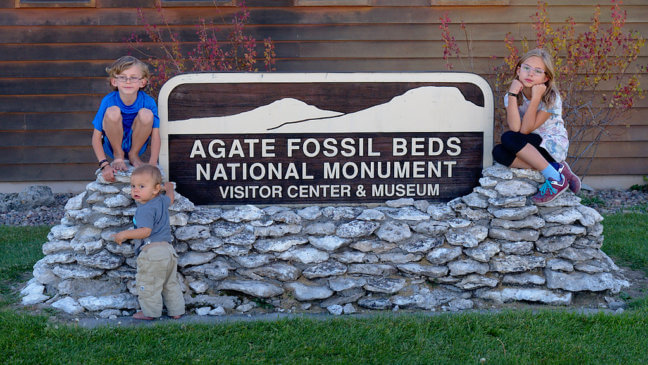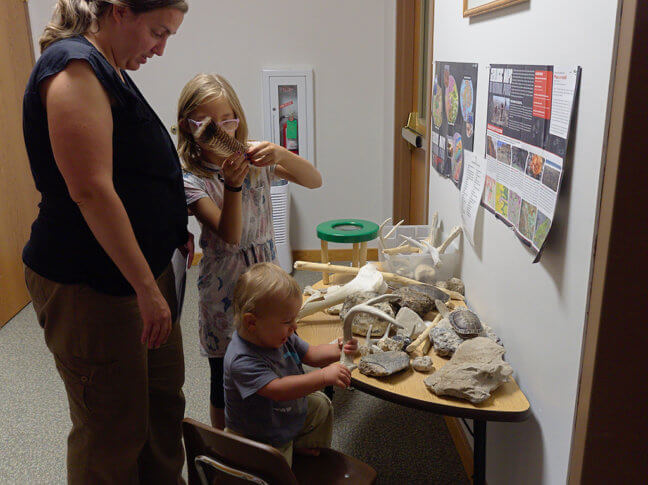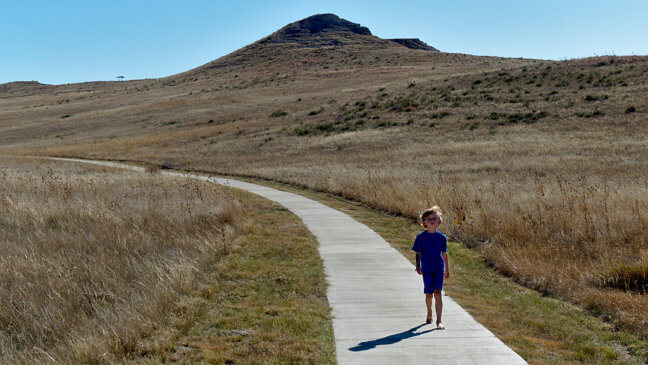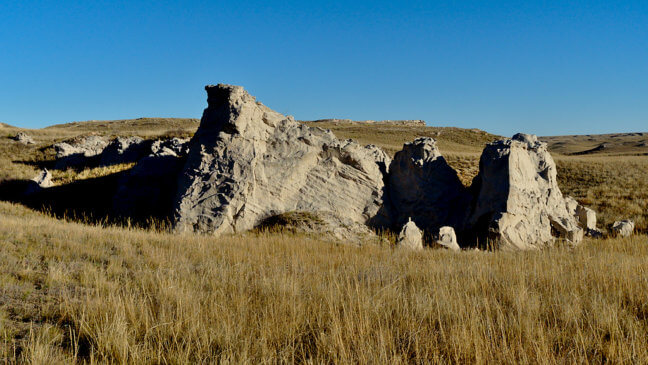Before we left Nebraska, while staying at Scotts Bluff, we took a day trip up to Agate Fossil Beds National Monument.

Parallel to our studies of the Oregon Trail, the kids were also learning about fossils as we anticipated traveling through some of the most fossil-rich areas of the country. Just as the Oregon Trail and the adventures of the pioneers easily captures a child’s imagination, it is equally easy to get kids interested in fossils of dinosaurs and other prehistoric creatures. It seems to come hard-wired into them. Most of us have probably met a 6 year old who can effortlessly pronounce names of dinosaurs with a half-dozen syllables. We’re raising one.
And so, with great anticipation but little research, we drove to rural western Nebraska, far from the nearest civilization or cell tower. It was a great park, but I wish we’d done our homework a little better and had more realistic expectations.
Things To Do
1. Visitor Center and Museum. We always start with the visitor center to get information and talk to a ranger about how best to experience a park. This is also a good opportunity to get Junior Ranger workbooks for the kids. The museum part here was small, but a good introduction to the area and the types of fossils found there. The area is believed to have been a watering hole between 5 and 23 million years ago that dried up during a drought, and all the animals that sought refuge there died in the same place. The fossils found were all mammals – no dinosaurs or other animals. It was discovered in the 1890s and remains one of the most significant finds of its kind.

The best part of the museum was the area where they had bones and fossils that kids could touch, hold, and explore.

2. Fossil Hills Trail. The best way to see the hills where the fossils were discovered is to hike the Fossil Hills Trail. Starting from the visitor center, the trail is 2.7 miles round trip. The ranger didn’t recommend it for us because of the kids, but she doesn’t know our kids. They’re used to walking and they were fine. The entire trail is paved and was easily stroller accessible. Technically the trail isn’t marked as accessible because at times the grade is too steep for regulations, but we didn’t find it to be an issue. It was a mild, steady climb, but I can’t say it felt like “hiking”.


It was a nice day for a walk but otherwise, the trail was disappointing. While the trail is marked with plenty of signs describing what was found at different locations, there is nothing of that left now. We brought our kids to Agate Fossil Bed and took them on the Fossil Hills trail, and they were expecting to see some fossils. Everything had been thoroughly excavated and removed. Nothing to see here, folks!


3. Daemonelix Trail. After driving out there, exploring the museum, taking a lunch break, and walking nearly 3 miles, our day was drawing to a close. On the way back to the main road there was another trail that we decided to explore before we left. It was only a mile, but after a long day, it was hard to motivate the kids to explore one more trail. I’m so glad we did, though, as this turned out to be the highlight of the whole day!
The Daemonelix (or “Devil’s Corkscrew”) are unique formations that were originally thought to be fossilized remains of an extinct freshwater sponge. In actuality, they are fossilized burrows made by the beaver-like paleocaster. We also saw unique rock formations that turned out to be petrified sand dunes.


This trail is definitely a must-see if you visit this park. These unique formations are fascinating! The trail is not as easily accessible as the Fossil Hills trail but we were still able to navigate it with a stroller. As we walked back to our car and sunset was approaching, a herd of deer crested the hill in the distance and ran together through the field. It was an idyllic moment that felt like it was staged for film.
Agate Fossil Beds National Monument is definitely worth a visit if you find yourself in the area. If you approach it with the right expectations, you can have a really great day enjoying western Nebraska’s rural beauty and seeing some unique natural phenomena.

This sounds like an interesting experience. How exactly can someone tell a petrified sand dune vs. a regular rock? That seems like a fine delineation. I guess that’s why people go here – to learn about things like that. I think we’ll skip the Agate Fossil Beds though, unless we’re desperate for something to do (and, no offense to people who love Nebraska, but if we’re in that state, we might end up being that desperate…). Glad it turned out a success for you in the end!
To be honest, I’m not sure. We read that on the sign. It didn’t look quite like a normal rock in texture, though, so I guess that’s part of how you can tell?
We enjoyed Nebraska so much more than we expected to! Scotts Bluff was wonderful and the Omaha Zoo easily rivals San Diego (but with a much smaller price tag!) I’ve posted about both of those if you haven’t seen them. We’re learning that there’s something worth experiencing almost anywhere you go!
That said, Agate wouldn’t be on the top of my must-see list.